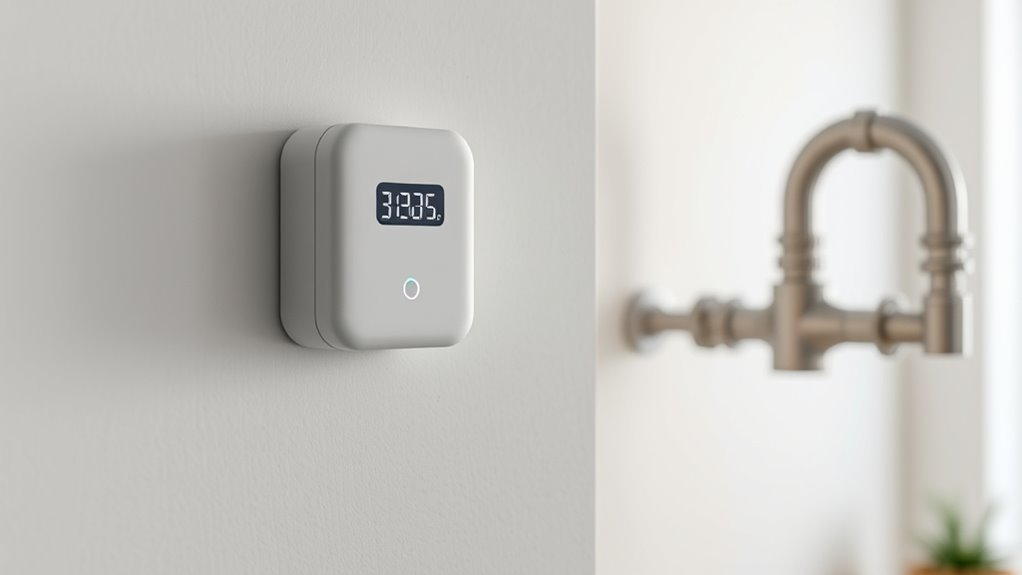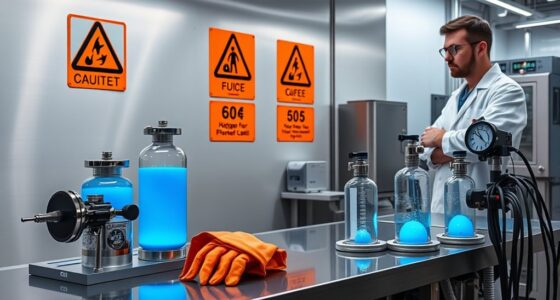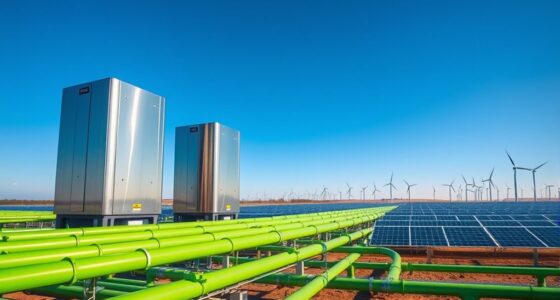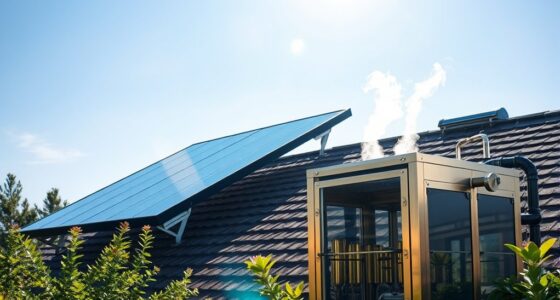Hydrogen leak detection sensors help you stay safe by quickly identifying leaks with features like fast response times, high accuracy, and reliable alerts. Place them near ceilings and potential leak sources, and guarantee they are calibrated regularly. Use sensors that detect low hydrogen levels, ideally set to alarm at 1%, and maintain proper testing routines. If you want to learn how to choose the right sensor and protect your home effectively, keep exploring this essential safety guide.
Key Takeaways
- Install sensors near ceilings and potential leak sources for early detection.
- Use non-toxic, environmentally safe detection gases and set alarms below flammability levels.
- Regularly calibrate and maintain sensors for accurate, reliable leak detection.
- Ensure sensors have quick response times (3-6 seconds) and clear alarm signals for safety.
- Follow safety standards, proper placement, and integrate alarms with home safety systems.
Understanding Hydrogen Leak Detection Technologies
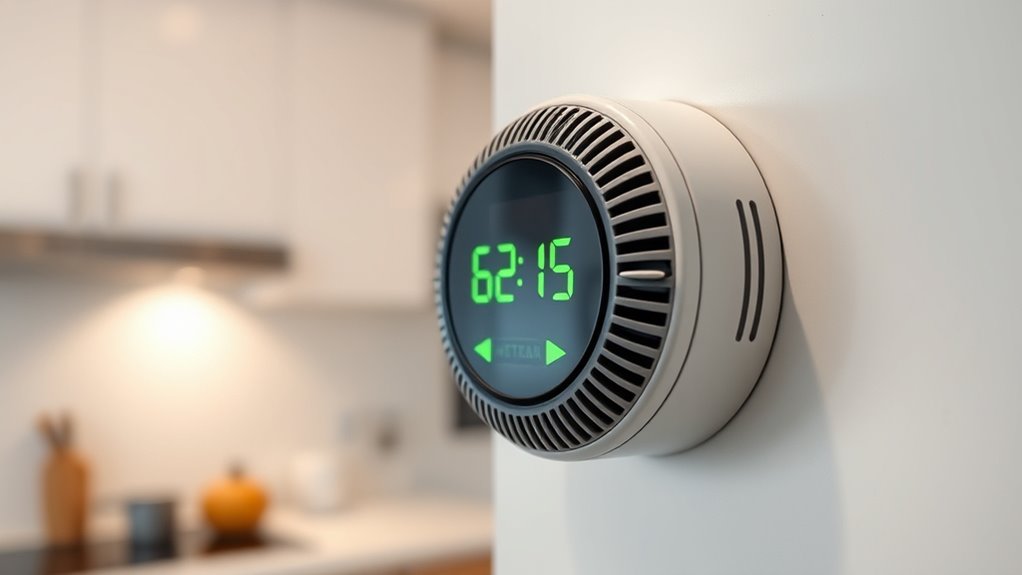
Hydrogen leak detection technologies play a crucial role in ensuring safety in various applications by identifying leaks early before they pose hazards. Thermal Conductivity Detection (TCD) measures changes in thermal conductivity caused by hydrogen, detecting leaks as small as 50 ppm and providing rapid, sensitive results suitable for industrial use. Optical Gas Imaging (OGI) uses infrared light absorption differences to visualize leaks remotely, ideal for outdoor inspections, but it needs trace gases and can be costly. Electrochemical sensors detect hydrogen through chemical reactions that produce electrical signals, making them suitable for real-time monitoring near explosive limits. Palladium thin-film sensors change properties upon hydrogen adsorption, offering high selectivity but may struggle in harsh conditions. Pressure and flow monitoring systems detect leaks indirectly by observing changes in piping pressure or flow rates. Additionally, some advanced sensors incorporate visualization techniques to enhance detection accuracy in complex environments.
Key Features to Look for in Home Hydrogen Sensors
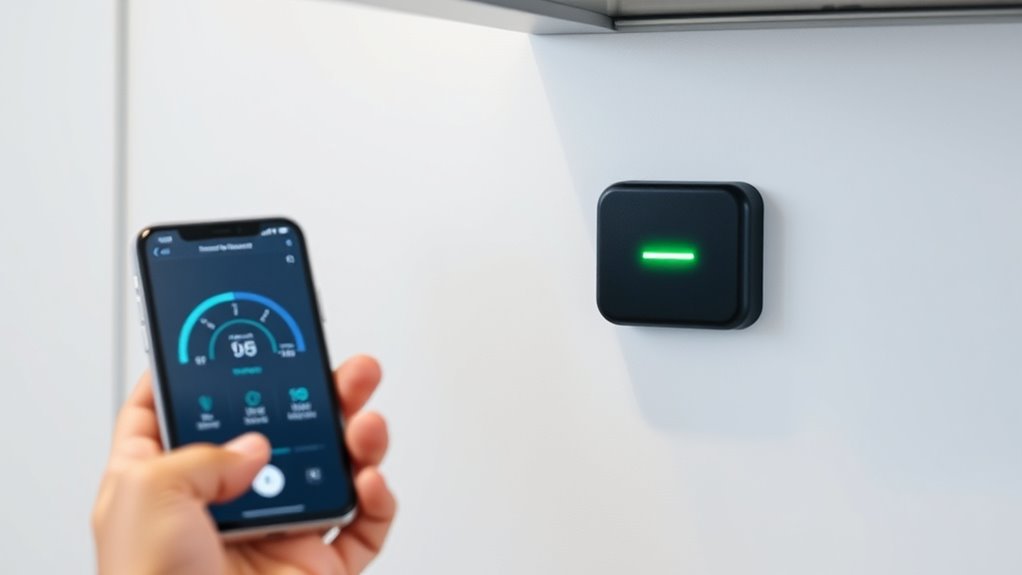
When choosing a home hydrogen sensor, it’s essential to take into account several key features that guarantee reliable and effective detection. First, check the measurement range; a good sensor covers 0-1000 ppm or up to 100% gas concentration for thorough monitoring. Response time matters—look for sensors that react within 3 to 6 seconds to ensure quick leak detection. Accuracy should be within +/- 1%, with a resolution of 0.1%, providing precise readings. Consider the output options—analog, PWM, or CAN—to match your setup. Field calibration adds flexibility, so sensors with web interface calibration are beneficial. Durability is critical; choose sensors rated IP65 and designed to operate in temperatures from -25°C to 60°C. Ease of installation, safety features, and certifications further guarantee your sensor’s reliability. Additionally, the sensors are designed to measure hazardous H2 concentrations precisely, ensuring consistent performance in various environments. Incorporating sensors with exposure to environmental factors resistance can enhance long-term reliability and safety.
Ensuring Safety With Proper Detector Placement and Use
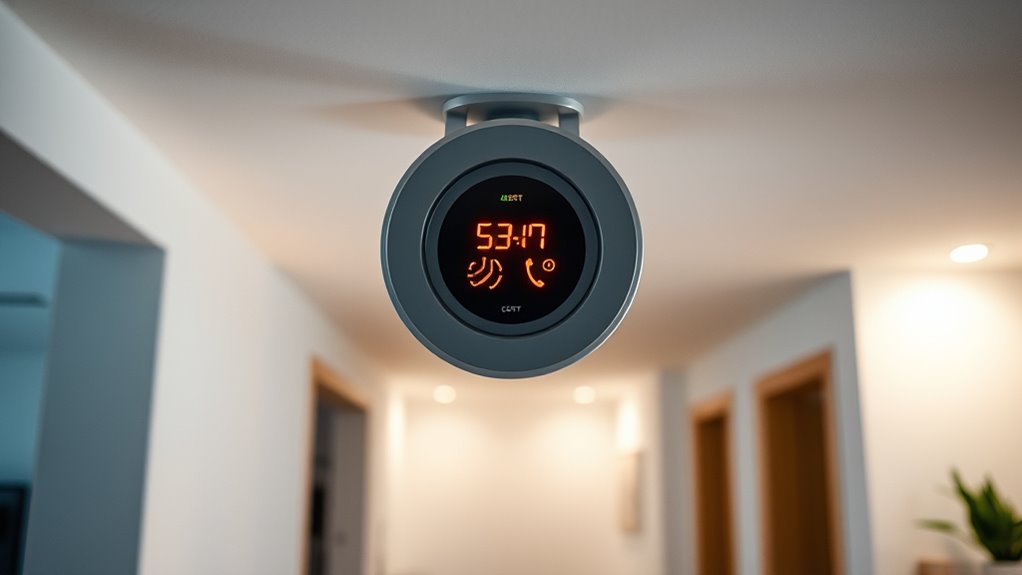
Proper placement of hydrogen leak detection sensors is crucial for guaranteeing safety and quick response. Since hydrogen is lighter than air, install detectors near the ceiling to maximize detection efficiency. Keep sensors away from electrical interference from devices like lights or radio repeaters, and position them close to potential leak sources for prompt detection. Consider airflow and ventilation patterns; place sensors in low-ventilation areas where hydrogen could accumulate. Confirm easy access for maintenance and calibration. For indoor spaces, install sensors up to two-thirds of room height, and avoid placing them in controlled atmosphere rooms. In critical areas, use multiple sensors for extensive coverage. Proper height installation ensures timely detection of leaking hydrogen. Proper placement minimizes false alarms and ensures rapid detection, helping you respond swiftly to potential leaks. Staying informed about emerging safety technologies can further enhance your home’s protection against hydrogen leaks.
How to Interpret Sensor Readings and Alarms
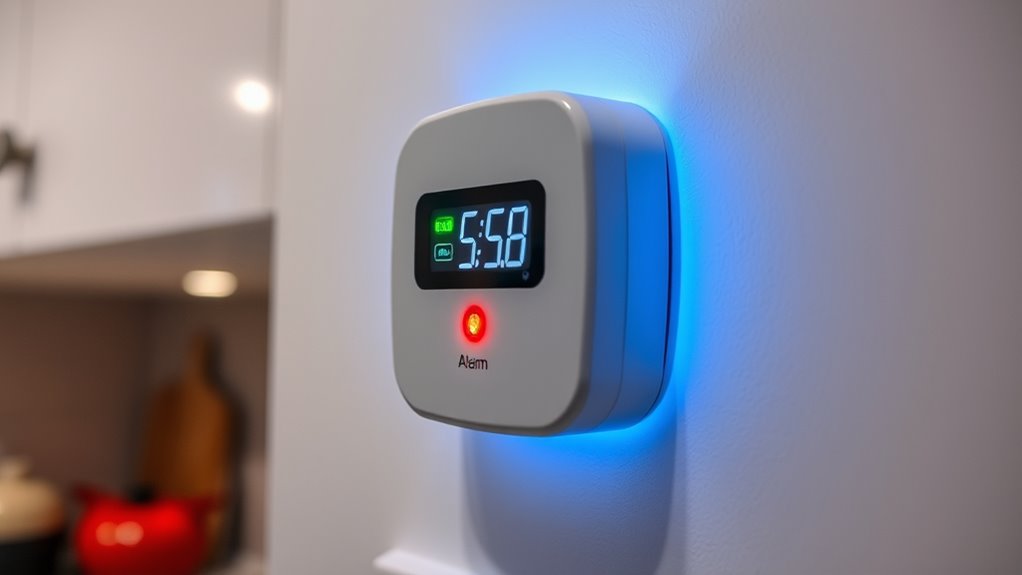
To interpret sensor readings and alarms accurately, you need to understand what different signals mean, especially regarding ppm levels. Recognizing how alarm signals correlate with hydrogen concentrations helps you respond appropriately. By keeping an eye on measurement units and alarm thresholds, you can better assess leak severity and act quickly. Understanding hydrogen’s physical and chemical properties is essential, because it influences how sensors detect leaks and how alarms are triggered. Being aware of detection mechanisms can help you differentiate between false alarms and real leaks.
Understanding Alarm Signals
Understanding alarm signals from hydrogen leak detection sensors is essential for ensuring safety and quick response. When an alarm sounds, pay attention to both the audible siren and visual indicators like strobes or beacons. These signals are designed to be unmistakable, even in noisy or bright environments, so you can respond promptly. Different alarms indicate varying risk levels: low alarms at 10-20% LEL warn of early leaks, while high alarms at 25-50% LEL signal urgent action is needed. Always recognize multi-modal alerts together, as they reduce missed signals. Remember, alarms should never reach 100% LEL to avoid False security. Clear, immediate signals help you assess the situation quickly and follow necessary safety protocols without delay. Monitoring the effectiveness of sensors is also crucial to ensure they are functioning properly and providing accurate readings.
Interpreting Ppm Levels
Interpreting ppm levels from hydrogen sensors is essential for evaluating leak severity and ensuring safety. PPM readings indicate hydrogen concentration, helping you determine if a leak is minor or dangerous. Levels below 1000 ppm usually mean a small leak or background presence, but monitoring is still necessary. When readings reach between 1000 and 4000 ppm, the risk increases, and continued observation or preventive actions are advised. Alarms at 4000 ppm (0.4%) signal a significant leak, requiring inspection, while levels above 10,000 ppm (1%) are critical, prompting immediate emergency response to prevent ignition. Keep in mind, trends over time matter; rising ppm levels indicate worsening leaks. Always consider environmental factors and sensor calibration to accurately interpret readings and maintain safety. The cybersecurity landscape continuously evolves, making it important to stay updated on sensor technology advancements for optimal safety.
Best Practices for Maintaining and Calibrating Detectors
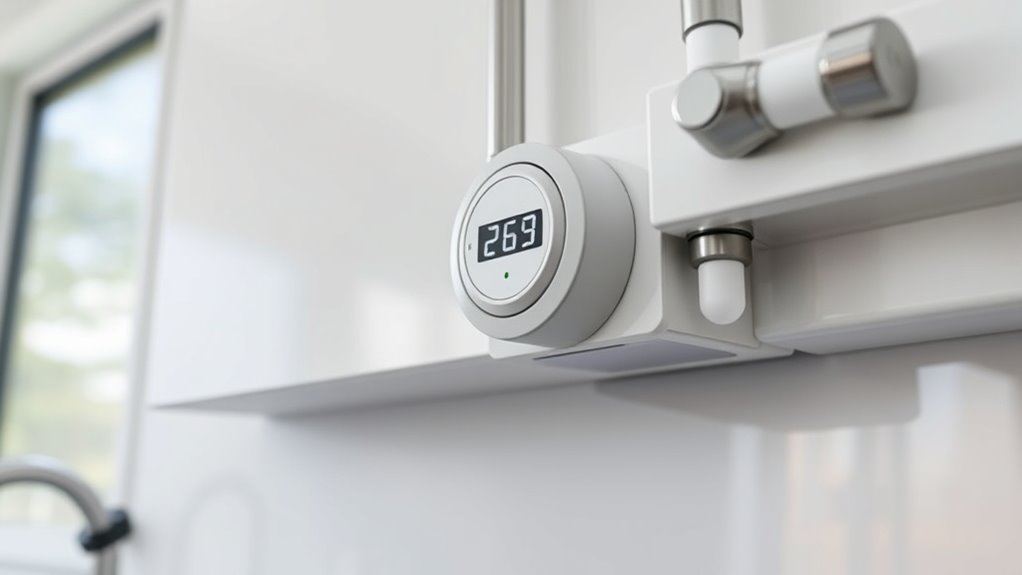
Maintaining and calibrating hydrogen leak detection sensors is essential for ensuring reliable safety performance. You should establish regular calibration schedules based on manufacturer guidelines, ensuring sensors remain accurate. Inspect detectors routinely for damage, corrosion, or contamination, and clean them properly to prevent malfunctions. Perform bump tests before calibration to verify response, then calibrate to zero and span points using certified gases. Always follow manufacturer instructions for calibration techniques and sensor replacement. Keep detailed records of maintenance, calibration activities, and repairs for compliance and troubleshooting. Regularly test alarm functions to confirm proper responses to hydrogen levels. Including service agreements with professionals can help maintain consistent performance. Proper upkeep guarantees your detectors provide accurate, dependable alerts, keeping your home safe from leaks. Additionally, understanding AI’s impact on privacy and regulation can help inform better safety practices and compliance standards.
Environmental and Safety Considerations in Leak Detection
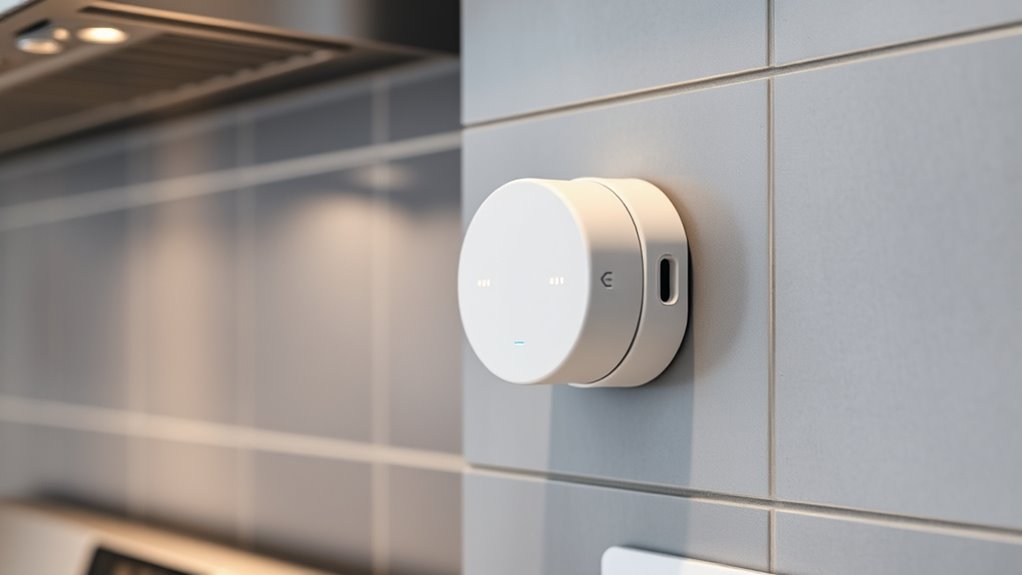
When choosing leak detection methods, you need to think about using non-toxic detection gases to guarantee safety during testing. It’s also essential to implement flammability prevention measures, since hydrogen’s high flammability poses explosion risks. Additionally, implementing monitoring protocols can help detect leaks early and prevent accidents. Finally, adhering to environmental safety standards helps protect ecosystems and public health from potential leaks. Controlling hydrogen leaks is crucial for minimizing environmental impacts.
Non-toxic Detection Gases
Why are non-toxic detection gases essential in hydrogen leak detection? Even though hydrogen itself isn’t toxic, using non-toxic detection gases ensures safety without introducing harmful substances into your home environment. These gases help identify leaks accurately without risking health issues or environmental harm. They also prevent accidental exposure that could occur with toxic alternatives. Non-toxic gases are particularly crucial because they reduce environmental impact, supporting efforts to lower emissions and mitigate climate effects. When combined with advanced sensors, these gases enable quick, reliable detection of leaks at low concentrations. This combination makes leak detection safer and more effective, improving safety, allowing you to respond promptly and prevent accidents. Overall, non-toxic detection gases provide a safer, eco-friendly way to monitor hydrogen leaks, giving you peace of mind in managing this clean energy source.
Flammability Prevention Measures
Implementing effective flammability prevention measures is essential for ensuring safety in hydrogen leak detection. You should set detectors to alarm at 1 vol% hydrogen, well below the flammability limit, to alert early. Regularly monitor piping pressures and flow rates for leaks. Place detectors in critical areas like enclosures and near piping, especially with annulus monitoring. Integrate alarms with automatic shutdowns to stop hydrogen flow immediately. Use ventilation systems that activate when hydrogen is detected, dispersing gas and reducing fire risk. The table below highlights key prevention measures:
| Measure | Description | Purpose |
|---|---|---|
| Early alarm threshold | Set at 1 vol% hydrogen | Early leak detection |
| Continuous monitoring | Pipe pressure and flow rate checks | Detect irregularities |
| Strategic detector placement | Enclosures and critical zones | Prompt leak detection |
| Automatic shutdown systems | Triggered by leak detection | Prevent escalation |
| Ventilation integration | Activated with gas detection | Minimize fire risk |
Furthermore, implementing routine maintenance and calibration of detection equipment enhances reliability and early detection capabilities. Regular calibration ensures that sensors maintain their accuracy over time, which is crucial for early leak detection and safety effectiveness.
Environmental Safety Standards
Regulatory compliance plays a crucial role in guaranteeing that hydrogen leak detection systems meet safety and environmental standards. Local authorities often mandate these systems to include automatic shutoff features that activate when leaks are detected. You should also confirm alarms—both audible and visible—are integrated to alert you promptly of unsafe hydrogen levels. Installation must follow explosive atmosphere regulations, placing sensors in sealed cabinets or near piping to prevent ignition risks. Dual-threshold alarms are common, warning at 25% of the Lower Flammable Limit (LFL) and shutting off at 50% LFL. Advanced sensors now support environmental monitoring, detecting low hydrogen concentrations and helping assess emissions’ environmental impacts. Proper ventilation, routine inspections, and operator training further guarantee safety, compliance, and environmental protection in hydrogen use. Hydrogen’s physical properties and explosive potential also necessitate rigorous safety measures to prevent leaks and manage hazards effectively. Ensuring sensor cybersecurity is critical to protect systems from malicious interference that could compromise safety protocols.
Applications of Hydrogen Sensors in Residential Settings
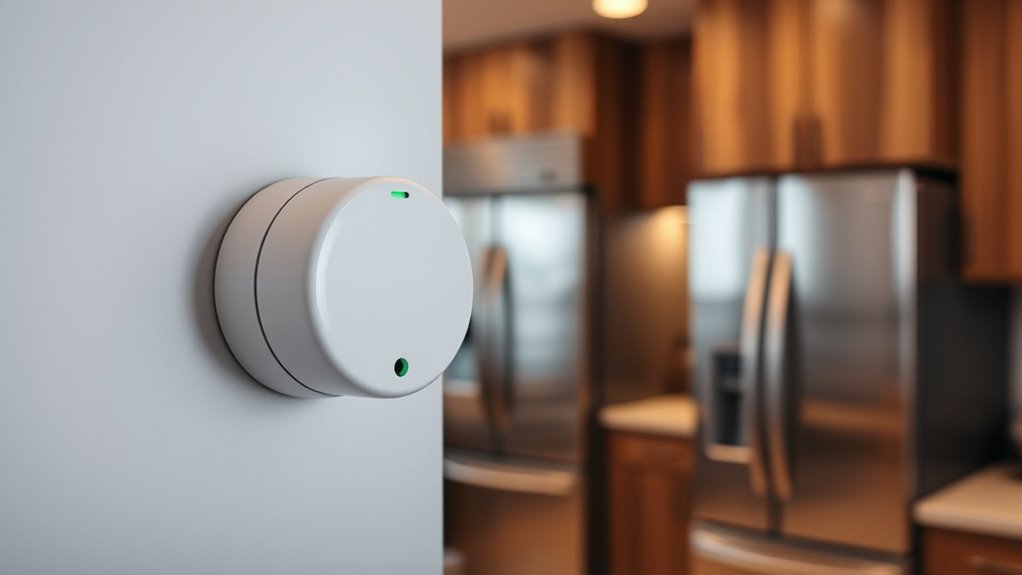
Hydrogen sensors play a vital role in maintaining safety within residential environments by detecting leaks from storage tanks, fuel cells, and plumbing systems before hazards develop. They help prevent explosions, fires, and unsafe accumulations. Imagine:
- Detecting hydrogen leaks early in storage tanks or battery rooms with sensors that sound alarms and alert you immediately.
- Pinpointing tiny leaks in hydrogen plumbing systems using portable detectors, even beneath concrete or asphalt surfaces.
- Monitoring air in HVAC systems to catch leaks from hydrogen-powered appliances before they become dangerous.
These sensors use electrochemical technology, detecting hydrogen at concentrations as low as 1 ppm. Proper placement near potential leak points guarantees rapid detection, keeping your home safe and compliant with safety standards.
Staying Ahead With the Latest Trends and Innovations
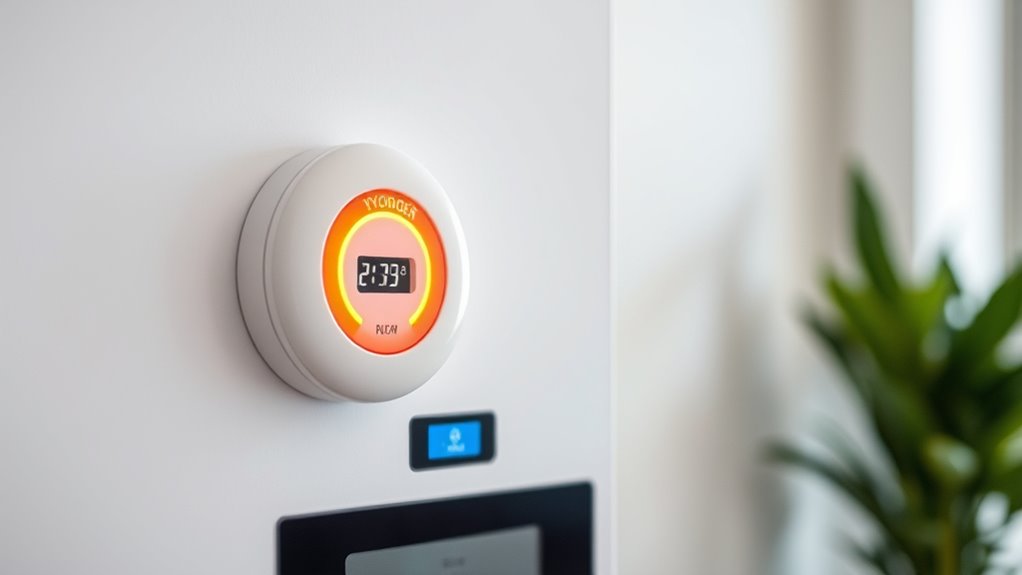
Advances in leak detection technology are guaranteeing how we guarantee safety in hydrogen applications. You can now benefit from sensors with heightened sensitivity, like Thermal Conductivity Detection (TCD), which detects leaks as low as 50 ppm. Honeywell’s latest detectors use compensation algorithms to cut False alarms and improve accuracy. Fibre optic sensors are emerging, providing early detection in transport and storage. Combining different sensor technologies broadens safety coverage, catching even microscopic leaks. Real-time monitoring allows you to intervene early, preventing hazards. Sensors embedded in equipment and vehicles enable seamless detection without disrupting operations. Data from these sensors supports proactive safety measures, making hydrogen systems safer for everyone. Staying ahead means adopting these innovations to protect your home and infrastructure effectively.
| Sensor Type | Key Benefit |
|---|---|
| Thermal Conductivity Detection | High sensitivity, detects tiny leaks |
| Honeywell’s HLD | Reduces False positives, improves accuracy |
| Fibre Optic Sensors | Early detection in critical infrastructure |
| Multiple Technologies | Broad-spectrum leak coverage |
| Real-time Monitoring | Immediate response and safety management |
Frequently Asked Questions
How Long Do Hydrogen Leak Detectors Typically Last Before Needing Replacement?
You’re wondering how long hydrogen leak detectors last before needing replacement. Typically, electrochemical sensors last 2 to 3 years, while semiconductor or solid-state sensors can last 5 to 7 years with proper care. Some handheld detectors may last up to 10 years. Factors like harsh environments, contaminants, and maintenance affect lifespan. Regular calibration and proper handling can extend your detector’s effective life, ensuring safety and reliable leak detection.
Are There Specific Certifications or Standards to Look for in Home Hydrogen Sensors?
Think of certifications as the trusted badges that guarantee your safety shield’s strength. When choosing home hydrogen sensors, look for certifications like UL 2075 and FM 6310, which act as your armor against hazards. These standards ensure your sensor’s reliability and compliance. Always opt for certified products, and don’t hesitate to seek expert advice. Staying informed about certifications keeps your home protected, like a lighthouse guiding you through safe waters.
Can Hydrogen Detectors Be Integrated With Home Security or Alarm Systems?
You can definitely integrate hydrogen detectors with your home security or alarm systems. Many models feature relay outputs, dry contacts, and alarms that connect seamlessly to your existing setup. They can trigger alarms, activate ventilation, or notify you remotely through data outputs like RS485 or analog signals. Just make certain the detector is compatible with your system and has the necessary certifications for safety and reliability. This integration enhances your home’s safety against hydrogen leaks.
What Are the Signs of Sensor Degradation or Malfunction in a Detector?
Imagine your hydrogen detector turning into a ticking time bomb—it’s vital to spot signs of sensor failure early! You’ll notice readings drifting wildly, alarms going off falsely, or failing bump tests. The sensor might respond sluggishly, show corrosion, or stop detecting leaks altogether. Environmental damage, neglect, or age can accelerate this. Regular calibration, testing, and maintenance keep your sensor reliable, ensuring it warns you before a disaster strikes.
How Do Environmental Factors Like Humidity or Temperature Affect Sensor Accuracy?
Environmental factors like humidity and temperature can markedly impact your sensor’s accuracy. High humidity may cause false readings or damage, while temperature fluctuations can lead to drift or decreased lifespan. To keep your sensor reliable, make sure it’s rated for your environment, perform regular calibration, and conduct scheduled maintenance. Protect it with enclosures if needed, and always follow manufacturer guidelines to maintain ideal performance and safety.
Conclusion
Remember, safety is no accident. By understanding how hydrogen leak sensors work, properly installing and maintaining them, and staying informed about new innovations, you’re taking vital steps to protect your home. Regular checks and prompt responses to alarms can prevent potential hazards. As the saying goes, “An ounce of prevention is worth a pound of cure.” Stay vigilant, stay safe, and keep your home secure with reliable hydrogen detection.
I’m Theodore, and I love tiny houses. In fact, I’m the author of Tiny House 43, a book about tiny houses that are also tree houses. I think they’re magical places where imaginations can run wild and adventures are just waiting to happen.
While tree houses are often associated with childhood, they can be the perfect adult retreat. They offer a cozy space to relax and unwind, surrounded by nature. And since they’re typically built on stilts or raised platforms, they offer stunning views that traditional homes simply can’t match.
If you’re looking for a unique and romantic getaway, a tree house tiny house might just be the perfect option.
